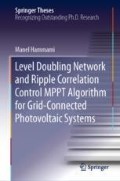Abstract
A maximum power point tracking (MPPT) control is necessary in photovoltaic (PV) generation system in order to extract maximum power from the PV arrays. Several MPPT techniques have been proposed and discussed in the literature.
Access this chapter
Tax calculation will be finalised at checkout
Purchases are for personal use only
References
S.E. Babaa, M. Armstrong, V. Pickert, T. Esram, P.L. Chapman, Overview of maximum power point tracking control methods for PV Systems. IEEE Trans. Energy Convers. 22(08), 59–72 (2014)
N. Femia, G. Petrone, G. Spagnuolo, M. Vitelli, Optimization of perturb and observe maximum power point tracking method. IEEE Trans. Power Electron. 20(4), 963–973 (2005)
D. Sera, L. Mathe, T. Kerekes, S.V. Spataru, R. Teodorescu, On the perturb-and-observe and incremental conductance MPPT methods for PV systems. IEEE J. Photovoltaics 3(3), 1070–1078 (2013)
M. Khaled, H. Ali, M. Abd-El Sattar, A.A. Elbaset, Implementation of a modified perturb and observe maximum power point tracking algorithm for photovoltaic system using an embedded microcontroller. IET Renew. Power Gener. 10(4), 551–560 (2016)
C. Li, Y. Chen, D. Zhou, J. Liu, J. Zeng, A high-performance adaptive incremental conductance MPPT algorithm for photovoltaic systems. Energies 9(4), 288 (2016)
M.A.M. Ramli, S. Twaha, K. Ishaque, Y.A. Al-Turki, A review on maximum power point tracking for photovoltaic systems with and without shading conditions. Renew. Sustain. Energy Rev. 67, 144–159 (2017). (January)
T. Esram, P.L. Chapman, Comparison of photovoltaic array maximum power point tracking techniques. IEEE Trans. Energy Convers. 22(2), 439–449 (2007)
R.M. Linus, P. Damodharan, Maximum power point tracking method using a modified perturb and observe algorithm for grid connected wind energy conversion systems. IET Renew. Power Gener. 9, 682–689 (2015)
L. Piegari, R. Rizzo, I. Spina, P. Tricoli, Optimized adaptive perturb and observe maximum power point tracking control for photovoltaic generation. Energies 8(5), 3418–3436 (2015)
T. Esram, J.W. Kimball, P.T. Krein, P.L. Chapman, P. Midya, Dynamic maximum power point tracking of photovoltaic arrays using ripple correlation control. IEEE Trans. Power Electron. 21(5), 1282–1290 (2006)
D. Casadei, G. Grandi, C. Rossi, Single-phase single-stage photovoltaic generation system based on a ripple correlation control maximum power point tracking. IEEE Trans. Energy Convers. 21(2), 562–568 (2006)
C. Boonmee, Y. Kumsuwan, Control of single-phase cascaded H-bridge multilevel inverter with modified MPPT for grid-connected photovoltaic systems, in IECON 2013—39th Annual Conference of the IEEE Industrial Electronics Society (2013), pp. 566–571
M. Hammami, G. Grandi, M. Rudan, An improved MPPT algorithm based on hybrid RCC scheme for single-phase PV systems, in IECON 2016—42nd Annual Conference of the IEEE Industrial Electronics Society (2016), pp. 3024–3029
M. Ebrahimi, S.A. Khajehoddin, M. Karimi Ghartemani, Fast and robust single-phase DQ current controller for smart inverter applications. IEEE Trans. Power Electron. 31(5), 3968–3976 (2015)
Authored Papers
M. Hammami, G. Grandi, M. Rudan, An improved MPPT algorithm based on hybrid RCC scheme for single-phase PV systems, in 42nd Annual Conference of the IEEE Industrial Electronics Society, IECON 2016, Florence, Italy, 24–27 Oct 2016
M. Vujacic, M. Srndovic, M. Hammami, G. Grandi, Evaluation of DC voltage ripple in single-phase H-Bridge PWM inverters, in 42nd Annual Conference of the IEEE Industrial Electronics Society, IECON 2016, Florence, Italy, 24–27 Oct 2016
Author information
Authors and Affiliations
Corresponding author
Rights and permissions
Copyright information
© 2019 Springer Nature Switzerland AG
About this chapter
Cite this chapter
Hammami, M. (2019). Basic RCC-MPPT Scheme in Single-Phase H-Bridge Grid-Connected PV Systems. In: Level Doubling Network and Ripple Correlation Control MPPT Algorithm for Grid-Connected Photovoltaic Systems . Springer Theses. Springer, Cham. https://doi.org/10.1007/978-3-030-10492-4_2
Download citation
DOI: https://doi.org/10.1007/978-3-030-10492-4_2
Published:
Publisher Name: Springer, Cham
Print ISBN: 978-3-030-10491-7
Online ISBN: 978-3-030-10492-4
eBook Packages: EngineeringEngineering (R0)

